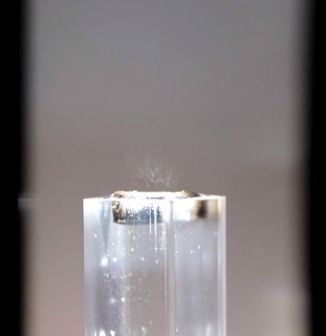NASA is making a plane that will go from NYC to LA in 2 hours.
Get the latest international news and world events from around the world.
Estonia To Offer Free Genetic Testing, And Other Nations May Follow
The initiative, which launched on March 20, will start by providing 100,000 of its 1.3 million residents with information on their genetic risk for certain diseases. Genetic information from the project will first be delivered to a family doctor, so that patients will receive counseling about what their results actually mean and how they can better adapt their lifestyle to avoid illness.
The nation of Estonia is establishing a program that provides both free genetic testing and health advice to all citizens based on their results.

Musk and Zuckerberg Are Fighting Over Whether We Rule Technology—Or it Rules Us
In the public imagination, the Amish are famous for renouncing modern technology. In truth, many Amish farms hum with machines: milk vats, mechanical agitators, diesel engines, and pneumatic belt sanders are all found in their barns and workshops.
The Amish don’t actually oppose technology. Rather, the community must vote on whether to adopt a given item. To do so, they must agree almost unanimously, says Jameson Wetmore, a social science researcher at Arizona State University. Whereas the outside world may see innovation as good until proven otherwise, the Amish first decide whether a new technology might erode the community values they’re trying to preserve. “It is not individual technologies the concern us,” one Amish minister told Wetmore, “but the total chain.”
It’s an idea that is resonating in Silicon Valley these days, where a debate over technology and its potential unintended consequences is cleaving the industry into rival camps—each with a tech titan as its figurehead.


Novel Hydrogel-Based Solar Vapor Generator Yields Clean Drinking Water
Finding a cheap and effective water purification process would have global implications.
A research team from the University of Texas at Austin’s Cockrell School of Engineering has developed a new cost-effective and compact technology that combines gel-polymer hybrid materials to improve the purification process for drinking water.
The new materials possess both hydrophilic—an attraction to water—qualities and semiconducting, or solar-absorbing properties. This enables the hydrogel to produce clean, safe drinking water from virtually any source, whether it’s from the oceans or contaminated supplies.

Press Room
NASA has selected 24 new Fellows for its prestigious NASA Hubble Fellowship Program (NHFP). The program enables outstanding postdoctoral scientists to pursue independent research in any area of NASA Astrophysics, using theory, observation, experimentation, or instrument development. Each fellowship provides the awardee up to three years of support.
The new NHFP preserves the legacy of NASA’s previous postdoctoral fellowship programs, the Hubble, Einstein and Sagan Fellowships. Once selected, fellows are named to one of three sub-categories corresponding to three broad scientific questions NASA has sought to answer about the universe:

Water purification breakthrough uses sunlight and ‘hydrogels’
According to the United Nations, 30,000 people die each week from the consumption and use of unsanitary water. Although the vast majority of these fatalities occur in developing nations, the U.S. is no stranger to unanticipated water shortages, especially after hurricanes, tropical storms and other natural disasters that can disrupt supplies without warning.
Led by Guihua Yu, associate professor of materials science and mechanical engineering at The University of Texas at Austin, a research team in UT Austin’s Cockrell School of Engineering has developed a cost-effective and compact technology using combined gel-polymer hybrid materials. Possessing both hydrophilic (attraction to water) qualities and semiconducting (solar-adsorbing) properties, these “hydrogels” (networks of polymer chains known for their high water absorbency) enable the production of clean, safe drinking water from any source, whether it’s from the oceans or contaminated supplies.
The findings were published in the most recent issue of the journal Nature Nanotechnology.

What if Apollo 11 had failed? Nixon’s undelivered speech
In 1969, William Safire was President Nixon’s speech writer. He wrote the short speech shown below, and delivered it to Chief of Staff, H.R. Haldeman. The speech was to be read by Nixon in the event that the Apollo 11 lunar lander failed to launch or that some other problem caused the lander or mothership to crash back onto the surface of the moon.
In 1969, the space race was at full throttle. Russians were first to launch a satellite, send a dog and a man into space,* and perform an extravehicular space walk. America was under great pressure to fulfill John F. Kennedy’s promise and beat the Russians in landing a man on the moon. Today, former engineers at NASA acknowledge that they believed the chances of such a catastrophe were more than 50%.

William Safire was a brilliant orator and linguist, known primarily as a columnist and journalist. He received the Presidential Medal of Freedom (from George Bush in 2006). He died in 2009.
The Apollo 11 disaster speech is pure poetry. It fits Nixon’s demeanor, while inspiring the public to continue support for exploration despite such a spectacular failure.
William Safire’s speech for President Nixon—in the event of a moon landing disaster:
Fate has ordained that the men who went to the moon to explore in peace will stay on the moon to rest in peace.
These brave men, Neil Armstrong and Edwin Aldrin, know that there is no hope for their recovery. But they also know that there is hope for mankind in their sacrifice.
These two men are laying down their lives in mankind’s most noble goal: the search for truth and understanding.
They will be mourned by their families and friends; they will be mourned by their nation; they will be mourned by the people of the world; they will be mourned by a Mother Earth that dared send two of her sons into the unknown.
In their exploration, they stirred the people of the world to feel as one; in their sacrifice, they bind more tightly the brotherhood of man.
In ancient days, men looked at stars and saw their heroes in the constellations. In modern times, we do much the same, but our heroes are epic men of flesh and blood.
Others will follow, and surely find their way home. Man’s search will not be denied. But these men were the first, and they will remain the foremost in our hearts.
For every human being who looks up at the moon in the nights to come will know that there is some corner of another world that is forever mankind.
* The US was first to send an animal into space. On June 11, 1948, Albert 1, a rhesus monkey, was launched on a V2 rocket. But this was a suborbital flight. It cleared the atmosphere but could not have sailed away from Earth’s gravity, nor even achieved orbit. The first animal to attain orbit was launched more than 9 years later. A dog, Laika, launched on board the Soviet Sputnik 2 spacecraft on November 3, 1957.
Source: Watergate.info


A close galactic pair
This image displays the galaxies NGC 4302 — seen edge-on — and NGC 4298, both located 55 million light-years away. They were observed by Hubble to celebrate its 27th year in orbit.
The galaxy NGC 4298 is seen almost face-on, allowing us to see its spiral arms and the blue patches of ongoing star formation and young stars. In the edge-on disc of NGC 4302 huge swathes of dust are responsible for the mottled brown patterns, but a burst of blue to the left side of the galaxy indicates a region of extremely vigorous star formation.
The image is a mosaic of four separate captures from Hubble, taken between 2 and 22 January 2017, that have been stitched together to give this amazing field of view. Two different types of light emitted by the galaxies — visible and near-infrared — have been combined to give a rich and colourful image. This light was captured by Hubble’s Wide Field Camera 3, one of the telescope’s most advanced imaging instruments.